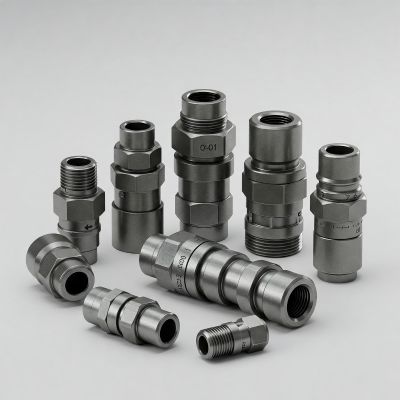Hydraulic fittings play a critical role in fluid systems, ensuring leak-free connections and maintaining system integrity under high pressure. Choosing the right hydraulic fitting is essential for efficiency, safety, and longevity in various applications, including industrial machinery, automotive systems, and aerospace components.
Compression fittings are a popular choice, but how do they compare to other common types, such as flare fittings, bite-type fittings, O-ring face seal (ORFS) fittings, and push-to-connect fittings? In this post, we’ll compare compression fittings with other hydraulic fittings to help you determine the best choice for your application.
Understanding Compression Hydraulic Fittings
What Are Compression Fittings?
Compression fittings create a secure, leak-resistant connection between tubes or pipes without welding or threading. They are commonly used in medium- to high-pressure applications where a reliable seal is required.
How They Work
Compression fittings use a ferrule-based sealing mechanism. When tightened, the ferrule compresses around the tubing, creating a secure and leak-proof connection.
Common Materials
➡️ Brass
➡️ Stainless steel
➡️ Carbon steel
Key Benefits
➡️ Easy installation and disassembly
➡️ No need for specialized tools
➡️ Leak-resistant design
➡️ Reusability with minimal maintenance
Typical Applications
➡️ Medium- to high-pressure hydraulic systems
➡️ Gas lines
➡️ Industrial fluid connections
Overview of Other Common Hydraulic Fittings
a. Flare Fittings
How They Work: Flare fittings feature a 37° or 45° flared tube end that creates a strong seal when connected.
Benefits:
➡️ High-pressure capability
➡️ Durable and resistant to vibration
Common Uses:
➡️ Aerospace
➡️ Automotive
➡️ Refrigeration industries
b. Bite-Type Fittings
How They Work: These fittings have a sharp ferrule that bites into the tubing, creating a strong grip and seal.
Benefits:
➡️ High-pressure performance
➡️ Secure, reliable connection
Common Uses:
➡️ Heavy-duty hydraulic systems
➡️ Pneumatic applications
c. O-Ring Face Seal (ORFS) Fittings
How They Work: ORFS fittings feature an O-ring in the fitting face that ensures a tight, leak-proof seal.
Benefits:
➡️ Excellent leak prevention
➡️ High-pressure and vibration resistance
Common Uses:
➡️ Hydraulic machinery
➡️ Industrial equipment
d. Push-to-Connect Fittings
How They Work: Push-to-connect fittings use a push-in mechanism for quick, tool-free installation.
Benefits:
➡️ Easy and fast installation
➡️ Ideal for low-pressure applications
Common Uses:
➡️ Pneumatic systems
➡️ Low-pressure hydraulic applications
Key Factors for Choosing the Right Hydraulic Fitting
When selecting a hydraulic fitting, consider the following factors:
➡️ Pressure Requirements – Which fittings can handle the highest pressures?
➡️ Ease of Installation – Which options are simplest to install?
➡️ Vibration Resistance – Which fittings perform best in high-vibration environments?
➡️ Leak Prevention – Which types offer the best sealing performance?
➡️ Maintenance and Reusability – Which fittings are easier to maintain or reuse?
➡️ Cost Considerations – What are the price differences among various fitting types?
Compression Fittings vs. Other Hydraulic Fittings: Pros and Cons
|
Feature |
Compression Fittings |
Flare Fittings |
Bite-Type |
ORFS |
Push-to-Connect |
|
Pressure Handling |
Medium-High |
High |
High |
Very High |
Low-Medium |
|
Leak Resistance |
High |
Medium-High |
High |
Very High |
Medium |
|
Installation Ease |
Easy |
Moderate |
Moderate |
Moderate |
Very Easy |
|
Vibration Resistance |
Medium |
High |
High |
Very High |
Low |
|
Reusability |
High |
Medium |
Low |
Medium |
High |
|
Cost |
Moderate |
Moderate |
High |
High |
Low |
Conclusion: Which One Is Best?
Each hydraulic fitting type has its own advantages and is suited for different applications:
➡️ Compression fittings are great for easy installation and reusability in medium- to high-pressure systems.
➡️ Flare fittings work well in high-pressure environments with strong vibration resistance.
➡️ Bite-type fittings offer excellent grip and security for heavy-duty hydraulic systems.
➡️ ORFS fittings provide superior leak prevention and are ideal for extreme pressure and vibration conditions.
➡️ Push-to-connect fittings are best for quick and easy installations in low-pressure applications.
Ultimately, the best fitting depends on your specific requirements, such as pressure rating, vibration resistance, and ease of maintenance.
Which hydraulic fitting do you use most frequently? Share your experiences in the comments below! If you’re looking for high-quality compression fittings or other hydraulic components, check out our product selection today.
For more expert guides on hydraulic systems, explore our related resources or contact us for professional advice!
Post time: Mar-17-2025


